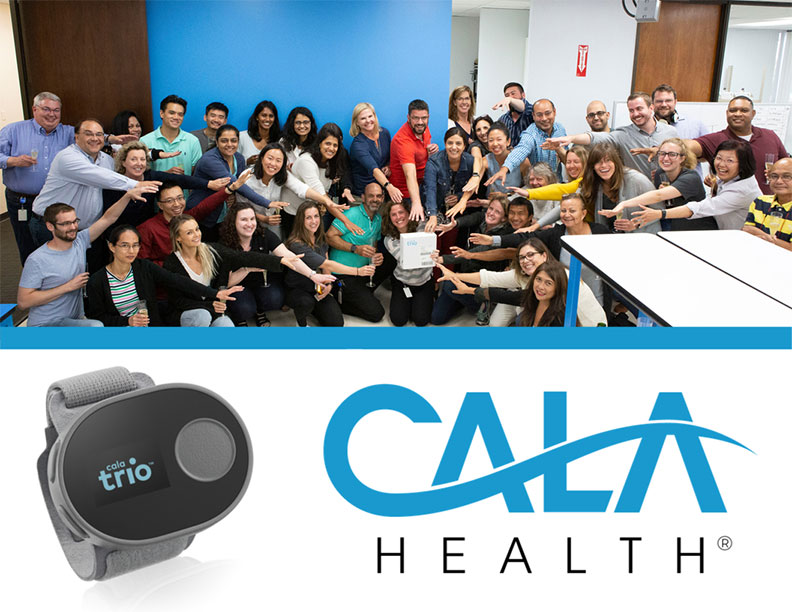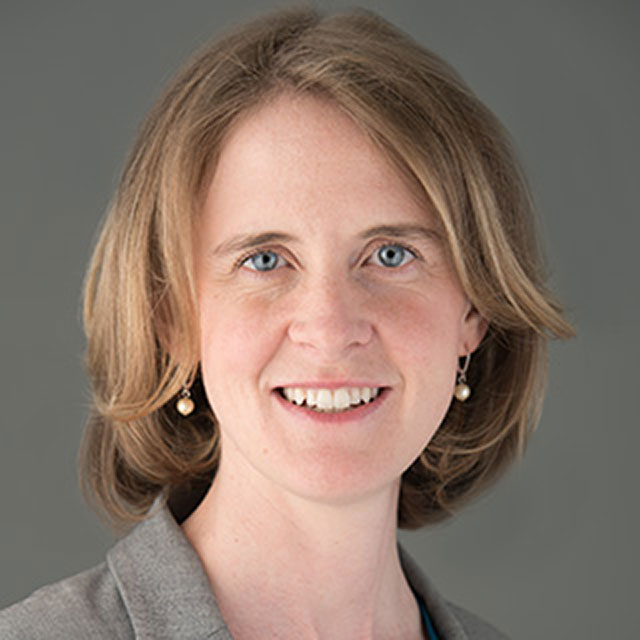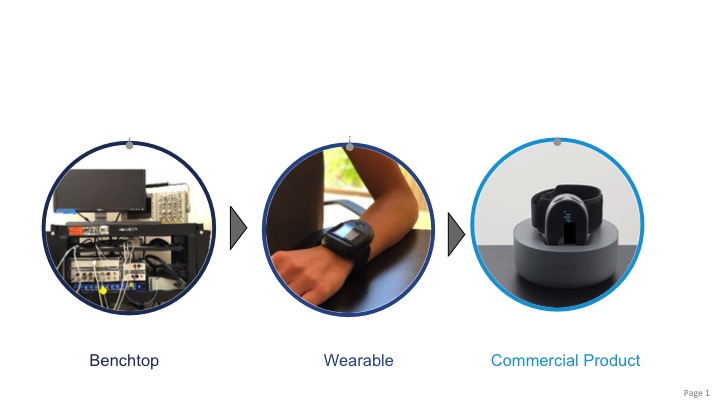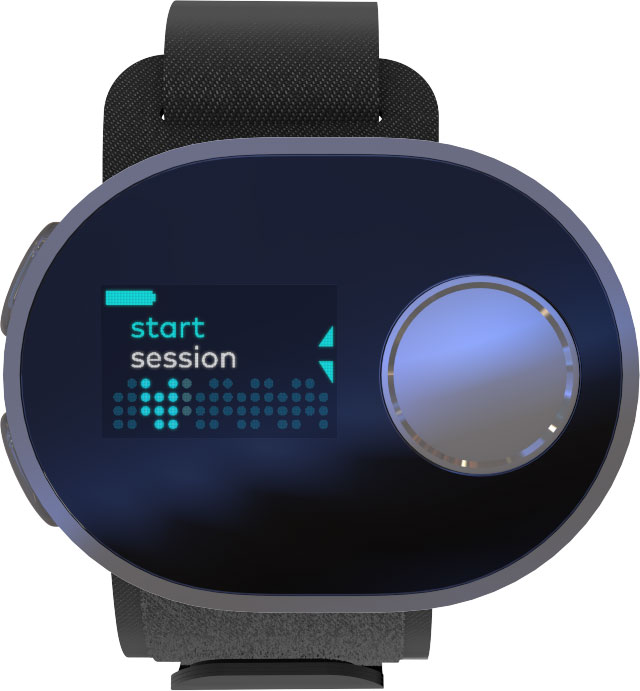Technologies
Cala Health Individualized, Non-Invasive Therapy for Essential Tremor –
An Interview with Kate Rosenbluth of Cala Health
What is the need Cala Health seeks to address?
When I was an Innovation Fellow, doing needs finding with my team, I met a man whose hands shook so badly that he could no longer write a letter to his wife or drink a coffee with a friend. He had a severe form of a debilitating disorder called essential tremor. He was desperate, and had just learned he was not a candidate for the brain surgery that he hoped would restore his hand control. He had tried medications, but they didn’t provide him relief.
As we observed more patients, we saw how they struggled to do tasks that so many of us take for granted, like putting a key in a lock or eating soup with a spoon. We were astonished to learn this condition was nearly eight times more common than Parkinson’s disease, with more than 7 million people living with essential tremor in the US alone.
What key insight was most important to guiding the design of your solution?
The key insight was realizing we could build on existing therapies to deliver a breakthrough solution. Through our research, we learned that medications provide relief from hand tremors for some patients, including certain blood pressure and anti-seizure medicines. The challenge was that when you take an oral medication, it gets into nearly every cell in your body. It’s diluted where you need it most, and causes side effects elsewhere. We wondered how it might be possible to do highly targeted drug delivery. Fortunately, the nervous system had already solved this problem for us. The nervous system is a network of highly targeted nerves, letting the brain know which toe you stubbed or sending messages about which muscle to flex. We realized that by stimulating nerves accessible at the wrist, we could provide highly targeted electrical medicines in the brain.
“The key insight was realizing we could build on existing therapies to deliver a breakthrough solution.”
In parallel, as neuroscientists and engineers, we were captivated by the circuitry connecting the brain dysfunction to the hand tremor. If surgery could treat tremor by implanting an electrical stimulator in the brain, couldn’t we reverse engineer the circuit to activate it outside the brain, on the wrist?
 Members of the Cala Health team, celebrating the Trio product launch.
Members of the Cala Health team, celebrating the Trio product launch.
How does your solution work?
Cala Trio is a non-invasive, wrist-worn device that provides on-demand relief from hand tremors caused by essential tremor. The device provides stimulation that is individually calibrated to each patient’s tremor. It affects the same neural circuitry that’s targeted by the surgical procedure and implant known as Deep Brain Stimulation. But, in our case, surface stimulation is delivered via the wrist and carried to the brain through the median and radial nerves, disrupting the pathological tremor frequency signals. This results in a significant short-term reduction of the tremor.
In controlled clinical trials, 62% of patients experienced meaningful symptom improvement after a 40-minute stimulation session using Cala Trio at home and 68% of users reported improvement in Activities of Daily Living, most notably in handwriting, holding a cup, and using a spoon. In a recent study of more than 250 patients using therapy twice daily for three months, users that experienced benefit reported tremor relief lasting up to an hour-and-a-half following therapy.
 This short promotional video, provided by Cala Health, illustrates how the company's technology is intended to work (see endorsement disclaimer below).
This short promotional video, provided by Cala Health, illustrates how the company's technology is intended to work (see endorsement disclaimer below).
At what stage of development is the solution?
Cala Trio received de novo marketing authorization from the FDA in April 2018. As of September 2019, I’m happy to announce that the product is available in select US markets with a fully supported customer success program. Our comprehensive patient service model combines both digital and human touch points to ensure a positive Cala Trio experience.
What are your plans for the future?
We see ourselves expanding in two important ways.
On the commercial side, we’re expanding our commercial model and connected ecosystem to service the full product life cycle, from receiving a prescription, to managing reimbursement, to drop-shipping product, to supporting patient usage at home. In parallel, we are developing next-generation capabilities integrate prescription electrical medicines with patient-facing services like telemedicine, medication management, and behavioral therapy.
On the product side, we're collaborating with leading scientists around the world to expand the platform into new indications, including therapies in neurology, psychiatry, and cardiology.
“Building a team with excellence at the intersection of medical devices, pharma, and consumer technology was a challenge.”
Tell us about a major obstacle you encountered and how you overcame it.
Building a team with excellence at the intersection of medical devices, pharma, and consumer technology was a challenge. We overcame this by bringing in strategic investors across the three fields.
What role did your Biodesign training play in enabling you to design, develop, and/or implement this solution?
Biodesign taught me the discipline of focusing on the unmet need before jumping to the solution. For us, this meant resisting the challenge to work on solutions too early in the process, which would have led to more incremental innovation with an embedded solution such as ‘more effective medication’ or ‘safer brain surgery.’ It makes me think of the quote from Henry Ford, ‘If I had asked people what they wanted, they would've said faster horses.’ But, by taking the time to really explore the unmet need, we were able to come up with a much more novel technology.
What advice do you have for other innovators about health technology innovation?
My advice would be to set the patient as your north star for your journey and then keep to that course. Healthcare is one of the most challenging areas for innovation because of the fragmented stakeholder landscape in which the person who recommends the product (the physician), pays for the product (the payer), and uses the product (the patient) are different. Working in health tech is an incredible opportunity to put your skills and passions to work in a field where you can literally change lives and save lives every day.
Kate Rosenbluth founded Cala Health out of the Biodesign Innovation Fellowship in 2013. To learn more, visit the Cala Health website.
Disclaimer of Endorsement: All references to specific products, companies, or services, including links to external sites, are for educational purposes only and do not constitute or imply an endorsement by the Byers Center for Biodesign or Stanford University.




